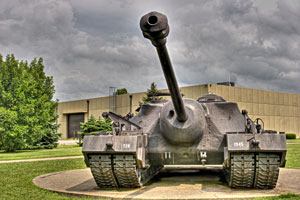The T28 (later called 105 mm Gun Motor Carriage T95) was a prototype heavily armoured tank destroyer, designed for the US Military during World War II. It was originally designed to be used to break through German defenses at the Siegfried Line, and was later considered as a possible participant in an invasion of the Japanese mainland.
It had no conventional turret, giving it a comparatively low profile. Its total weight when fully equipped would have reached 95 short tons. The armor was very thick compared to tanks of the time, in some places up to 12 inches thick (305 millimeters). This was considered heavy enough to provide protection from the 8.8cm/L71 cannon used by German heavy tanks. The engine was an underpowered gasoline Ford GAF V-8, delivering 410 hp, which gave it a top speed of about 8 mph (13 km/h). This also meant that the tank had only limited obstacle climbing capabilities and this, in addition to the fact that no suitable portable bridges capable of carrying its weight were available mitigated against production for combat deployment. Because of the tank destroyer's great weight, it used four tracks instead of two. The outer tracks could be detached for easier transport. After removal they could be fixed together to make a unit that could be towed behind the tank.
 Its main armament was a 105 mm T5E1 gun in a ball-shaped mantlet, set into the front of the hull. It also had a fifty-caliber machine gun above the commander's hatch. Its main armament was a 105 mm T5E1 gun in a ball-shaped mantlet, set into the front of the hull. It also had a fifty-caliber machine gun above the commander's hatch.
Although sometimes referred to as a super-heavy tank the T28 was, in reality, a very heavy tank destroyer, and was re-designated as the 105 mm Gun Motor Carriage T95 in 1945. In 1946 it was renamed again, to T28.
The original plan was for five prototype vehicles with a production total of 25. However only two were ordered and neither saw combat. One was heavily damaged by an engine fire during trials and was scrapped. The remaining prototype was discovered abandoned in a back field at Fort Belvoir. It is the only remaining example of these tanks and can be viewed at the Patton Museum of Cavalry and Armor in Kentucky. |